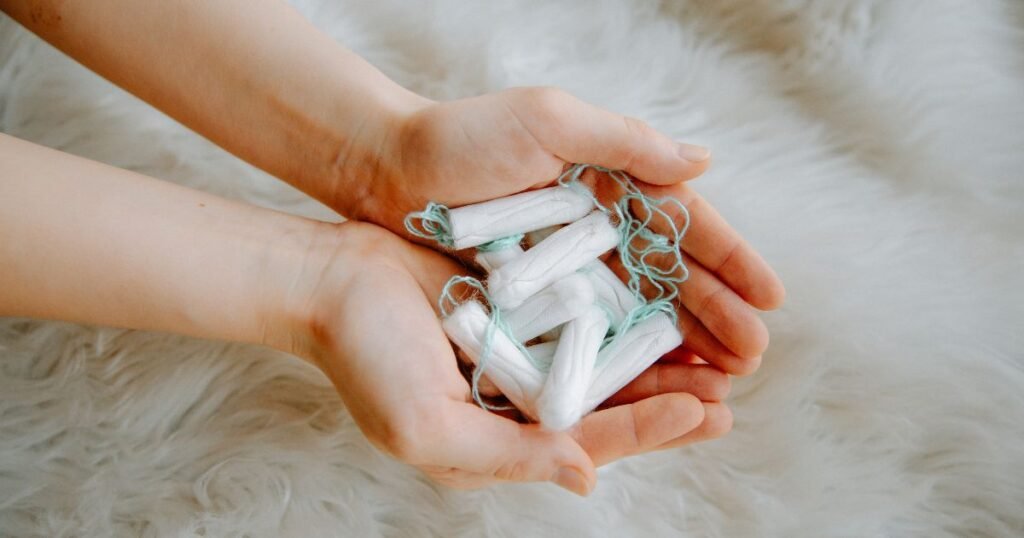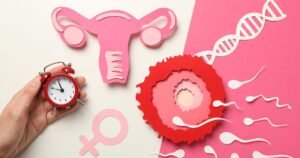Last Updated on 18 May 2024
I often welcome new mothers to my clinic seeking guidance on postpartum care. One of the questions I am asked is When can you use a tampon after birth? After giving birth, many women are eager to return to their normal routines, but it is essential to proceed cautiously to ensure optimal healing and well-being.
Giving birth is a transformative experience that brings about many changes to your body. You must focus on recovering from the delivery and getting accustomed to life with your new baby. During the postpartum period, it is essential to prioritize your healing and take proper care of your body. In this blog, we will provide expert advice on when you can safely use a tampon after giving birth.
Before diving into the topic, let’s understand the postpartum recovery process and how it affects your menstrual cycle. After giving birth, your body goes through a healing process, both internally and externally. Whether you had a vaginal birth or a cesarean section, your body needs time to heal and regain strength. The postpartum period is when your body undergoes physical and hormonal changes after childbirth. During this period, you may experience bleeding, discharge, and other postpartum symptoms.
Understanding the impact of childbirth on your menstrual cycle is essential to determining when it is safe to use tampons. Hormonal changes, breastfeeding, and the healing process all play a role in the timing of your first period after giving birth. It’s essential to consult with your healthcare provider for personalized advice and guidance throughout this journey.
The Return of Your Period After Birth
The return of your period after giving birth is a unique experience for every individual. While some people may experience their first period around six to eight weeks after delivery, others may have a longer or shorter interval. Factors such as breastfeeding, hormonal changes, and your body’s healing process can influence the timing of your first postpartum period.
It is important to note that the first period after childbirth differs from your regular menstrual cycle. It may involve heavier bleeding, more intense cramping, or irregular flow. This is because your body is still adjusting and finding its new normal after pregnancy. If you experience excessively heavy bleeding or have concerns about your first period after giving birth, it’s important to consult with your healthcare provider for guidance and reassurance.
Factors Influencing the Timing of Your First Postpartum Period
Several factors influence when your first postpartum period will occur. One of the most significant factors is whether you are breastfeeding. Breastfeeding can delay the return of your period because the hormone prolactin, which promotes milk production, suppresses ovulation. The frequency and duration of breastfeeding sessions can impact the prolactin level in your body, further affecting the timing of your first period.
Estrogen levels also play a role in the resumption of your menstrual cycle. Estrogen levels decrease during pregnancy and remain low during breastfeeding, which contributes to the delay in ovulation and menstruation. As your hormone levels regulate and breastfeeding patterns change, your estrogen levels may increase, signaling the return of your period.
If you are using hormonal birth control methods, such as the contraceptive pill or an intrauterine device (IUD), these can also influence the timing of your first period after childbirth. It’s important to consult with your healthcare provider about the best birth control options for your postpartum period and to discuss their impact on your menstrual cycle.
What to Expect from Your First Period After Delivery
Your first period after giving birth may differ from your pre-pregnancy periods in various ways. Some individuals may experience heavier blood loss, while others may have a lighter flow. The length of your period may also vary, with some people experiencing shorter or longer cycles than before.
Menstrual cramps can also be different after childbirth. Some individuals may experience more intense cramping, while others may notice a decrease in cramps. It’s essential to listen to your body and consult your healthcare provider if you have any concerns or questions about your postpartum period.
During your first period after delivery, you may find that you need to use a larger tampon than before. This is because the vaginal muscles and pelvic floor may still be recovering from the stress of childbirth. It’s important to choose the correct absorbency and consult with your healthcare provider for personalized advice on using tampons after giving birth.
Introduction to Using Tampons After Giving Birth
Using tampons is a personal choice and preference for many individuals during their menstrual cycle. However, after giving birth, it’s important to consider the impact of tampon use on your healing process. Your healthcare provider can provide guidance and recommendations on when it is safe to start using tampons after childbirth.
Tampons are internal sanitary products that are inserted into the vagina to absorb menstrual flow. They can provide convenience and comfort during your menstrual cycle. However, during the postpartum period, the vaginal area needs time to heal, especially if you had a vaginal birth. It is essential to prioritize your healing and consult with your healthcare provider before using tampons after giving birth.
Safety Concerns with Using Tampons in the Early Postpartum Period
Using tampons in the early postpartum period can pose certain risks and may hinder the healing process. The vaginal area undergoes significant changes after childbirth, and using tampons too soon can increase the risk of complications.
One concern is the risk of blood clots. After giving birth, your body is more prone to forming blood clots, and the use of tampons can increase this risk. Additionally, tampons can introduce bacteria into the healing vaginal area, leading to potential infections. If you had a vaginal delivery and required stitches, tampon use can disrupt the healing process and increase the risk of infection.
To ensure your safety and promote proper healing, it is best to wait until your healthcare provider gives you the green light before using tampons after giving birth. Consulting with your healthcare provider and following their recommendations is crucial for your postpartum recovery.
Recommended Time to Wait Before Using Tampons
The timing of when it is safe to use tampons after giving birth can vary depending on your healing process. It is important to consult with your healthcare provider for professional medical advice tailored to your specific needs. Your healthcare provider will consider factors such as the type of delivery, the healing progress of your vaginal area, and the presence of lochia (postpartum discharge).
In general, it is recommended to wait at least six weeks after giving birth before using tampons. This allows for proper healing of the vaginal area and reduces the risk of infection. Before using tampons, it’s essential to attend your postnatal check with your healthcare provider, who can assess your healing progress and provide personalized advice on when it’s safe to use tampons after childbirth.
During the early postpartum period, when tampons are not recommended, there are alternatives available for managing menstrual bleeding. One popular option is witch hazel maternity pads. These pads are designed for postpartum use, providing optimal absorbency and comfort. They are softer and more flexible than regular pads, allowing for better movement and reducing the risk of irritation.
Another alternative to tampons is menstrual cups. Menstrual cups are reusable devices that collect menstrual blood. They are made of medical-grade silicone or latex rubber and can be worn for up to 12 hours. Menstrual cups are safe after childbirth, but it’s important to consult your healthcare provider to ensure that your body has healed enough to use them comfortably.
Both maternity pads and menstrual cups offer convenience and comfort during the early postpartum period, providing reliable protection for your menstrual flow.
Benefits of Pads and Menstrual Cups
Using pads and menstrual cups in the early postpartum period offers several benefits. One of the main advantages is hygiene. Both pads and menstrual cups help contain and absorb menstrual flow, reducing the risk of leaks and keeping you fresh and clean.

Pads are convenient and easy to use. They can be easily changed as needed, and various sizes and absorbencies are available to suit your specific needs. Pads also allow for better airflow, reducing the risk of irritation and promoting the healing of any perineal tears or stitches.
Menstrual cups, on the other hand, offer convenience and long-lasting protection. Depending on your flow, they can be worn for up to 12 hours. Menstrual cups are also more environmentally friendly, as they are reusable and produce less waste than disposable pads.
Both pads and menstrual cups are suitable for heavy bleeding, providing the necessary absorbency to manage postpartum flow. It’s important to choose the option that feels most comfortable for you and fits well with your individual needs.
Choosing the Right Product for Your Body and Flow
Choosing the right product for your body and flow is essential when managing menstruation after childbirth. Factors such as the type of birth you had, the heaviness of your flow, and your comfort should all be taken into account. If you had a vaginal birth, it’s essential to give your body time to heal before using tampons. Your healthcare provider will advise when it is safe to use tampons after childbirth. In the meantime, maternity pads and menstrual cups are recommended options.
When selecting pads or menstrual cups, consider the flow of your menstrual period. If you have a heavy flow, opt for thicker, more absorbent pads or a larger-sized menstrual cup. You may prefer thinner pads or a smaller menstrual cup if your flow is lighter. Comfort is also essential when choosing a product. Look for pads or menstrual cups that are soft, flexible, and made from breathable materials. This will help prevent irritation and promote healing.
Ultimately, the right product for you depends on your needs and preferences. It is always a good idea to consult your healthcare provider or a knowledgeable pharmacist to ensure you choose the best option for your postpartum body.
When can you use a tampon after birth?
Knowing when you are ready to use tampons again after giving birth is important for your vaginal health and overall comfort. It is recommended to consult with your healthcare provider before using tampons to ensure that your body has fully healed and that it is safe to use them.
Your healthcare provider will consider factors such as the type of birth you had, any complications you experienced, and the state of your postpartum period and menstrual cycle. They can provide personalized advice based on your circumstances and help determine the appropriate time to reintroduce tampons. It is important to listen to your body and consider any discomfort or unusual symptoms you may be experiencing. If you have any concerns or questions, don’t hesitate to seek guidance from your healthcare provider.
Physical Readiness and Comfort Levels
Physical readiness and comfort levels are essential considerations when deciding to use tampons after giving birth. Your body goes through a healing process after childbirth, and it’s essential to give it time to recover before using tampons. Pay attention to your vaginal comfort and any postpartum symptoms you may be experiencing. If you’re still experiencing discharge or spotting, it may be a sign that your body is still healing and not ready for tampon use yet.
It is usual for postpartum bleeding and discharge to occur for several weeks after giving birth, and it can take time for your body to return to its pre-pregnancy state. If you’re unsure about using tampons, it’s best to err on the side of caution and continue using pads until you feel comfortable and have your healthcare provider’s approval.
Consulting with Healthcare Providers for Personalized Advice
When it comes to using tampons after giving birth, consulting with your healthcare provider is crucial. They have the expertise and knowledge to provide personalized advice based on your specific circumstances and needs. During your postnatal check, your healthcare provider will assess your overall health and well-being, including your vaginal health. They will be able to determine if your body has fully healed and if tampons are safe.
Your healthcare provider can also provide guidance on any concerns or questions you may have regarding tampon use after giving birth. They can discuss the best practices for using tampons, address any potential risks or complications, and ensure that you are using the appropriate products for your vaginal health.
In conclusion, knowing when to use a tampon after giving birth is crucial for your postpartum recovery. Factors like childbirth method, breastfeeding, and personal comfort play a role in determining when it’s safe to make the switch. Prioritizing your health and consulting with healthcare providers for any concerns is essential. Remember, your body’s healing process is unique, so listen to its cues and make choices that best support your well-being during this transformative time.









